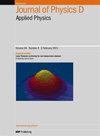Controllable dual resonances of Fano and EIT in a graphene-loaded all-dielectric GaAs metasurface and its sensing and slow-light applications
IF 3.2
3区 物理与天体物理
Q2 PHYSICS, APPLIED
引用次数: 0
Abstract
Active nanophotonic metasurfaces have attracted considerable attention for their promise to develop compact, tunable optical metadevices with advanced functions. In this work, we theoretically demonstrated the dynamically controllable dual resonances of Fano and electromagnetically induced transparency (EIT) using a graphene-loaded all-dielectric metasurface with U-shaped gallium arsenide (GaAs) nanobars operating in the near-infrared region. The destructive interference between a subradiant mode (i.e. a dark mode) supported by two vertical GaAs bars and two radiative modes (i.e. two bright modes) supported by a horizontal GaAs nanobar gives rise to a Fano resonance and an EIT window with high transmission and a large quality factor (Q-factor) in the transmission spectrum. Importantly, the transmission amplitudes can be flexibly modulated by adjusting the graphene Fermi levels without rebuilding the nanostructures. This modulation results from the controllable light absorption by the loaded graphene monolayer due to its interband losses in the near-infrared spectrum. Furthermore, the peak wavelengths of the Fano resonance and EIT window with high Q-factors are highly sensitive to variations in the refractive index (RI) of the surrounding medium, giving the proposed metasurface a relatively good sensitivity of ∼700 nm RIU−1 and a high figure of merit of 280, making it an effective RI sensor. Additionally, the metasurface features an adjustable slow light effect, indicated by the adjusted group delay time ranging from 0.12 ps to 0.38 ps. Therefore, the metasurface system proposed in this work offers a viable platform for advanced multi-band optical sensing, low-loss slow light devices, switches, and potential applications in nonlinear optical fields.石墨烯负载全介电砷化镓超表面中的法诺和 EIT 可控双共振及其传感和慢光应用
有源纳米光子元表面因其有望开发出具有先进功能的紧凑型可调光学元器件而备受关注。在这项工作中,我们从理论上证明了利用石墨烯负载的全介质元表面与工作在近红外区域的 U 型砷化镓(GaAs)纳米棒,可动态控制法诺和电磁诱导透明(EIT)双共振。由两根垂直砷化镓纳米棒支持的亚辐射模式(即暗模式)和由一根水平砷化镓纳米棒支持的两个辐射模式(即两个亮模式)之间的破坏性干涉产生了法诺共振和具有高透射率的 EIT 窗口,并且在透射光谱中具有较大的品质因数(Q 因子)。重要的是,可以通过调整石墨烯费米级来灵活调制透射幅度,而无需重建纳米结构。这种调制源于负载石墨烯单层在近红外光谱中的带间损耗所产生的可控光吸收。此外,具有高 Q 因子的法诺共振和 EIT 窗口的峰值波长对周围介质的折射率(RI)变化高度敏感,这使得所提出的元表面具有相对较好的灵敏度(RIU-1 ∼ 700 nm)和 280 的高优点,使其成为一种有效的 RI 传感器。此外,元表面还具有可调节的慢光效应,可调节的群延迟时间范围为 0.12 ps 至 0.38 ps。因此,本研究提出的元表面系统为先进的多波段光学传感、低损耗慢光器件、开关以及非线性光学领域的潜在应用提供了一个可行的平台。
本文章由计算机程序翻译,如有差异,请以英文原文为准。
求助全文
约1分钟内获得全文
求助全文
来源期刊
CiteScore
6.80
自引率
8.80%
发文量
835
审稿时长
2.1 months
期刊介绍:
This journal is concerned with all aspects of applied physics research, from biophysics, magnetism, plasmas and semiconductors to the structure and properties of matter.

 求助内容:
求助内容: 应助结果提醒方式:
应助结果提醒方式:


